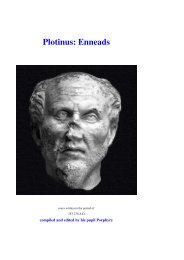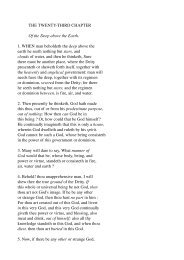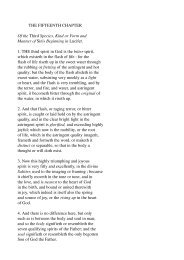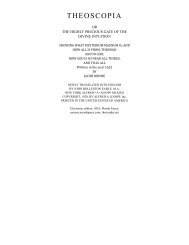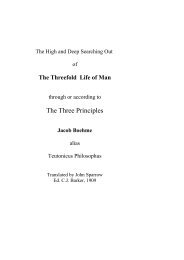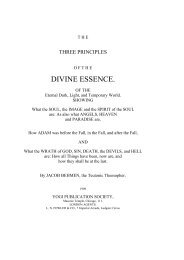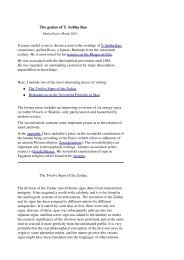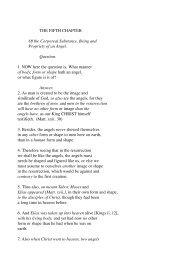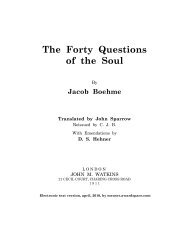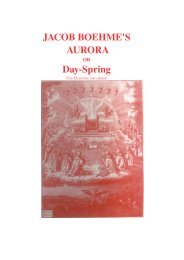Gerald Massey's Lectures - Society in evolution - Awardspace
Gerald Massey's Lectures - Society in evolution - Awardspace
Gerald Massey's Lectures - Society in evolution - Awardspace
Create successful ePaper yourself
Turn your PDF publications into a flip-book with our unique Google optimized e-Paper software.
night, the representative of his power <strong>in</strong> the six upper signs, whilst the sun was <strong>in</strong> the six<br />
lower signs, is the child as Horus, as the re-born Tum=Tum-mes, Tammuz, Apollo,<br />
Merodach, the hero, the warrior aga<strong>in</strong>st the dragon, and the powers of darkness at night<br />
or dur<strong>in</strong>g the lunar eclipse, the Masu, the ano<strong>in</strong>ted, the only begotten, furnished by the<br />
past as a factor <strong>in</strong> the theology of the present, which meets with no recognition<br />
whatsoever from Professor Sayce, or from any other writers on mythology who are<br />
known to me.<br />
Except <strong>in</strong> the technique of his scholarship, one sees but little sign that the professor has<br />
thought out his far-reach<strong>in</strong>g subject fundamentally. For example, Berossos repeats a<br />
Babylonian description of nature, which he dist<strong>in</strong>ctly affirms to have been allegorical.<br />
The professor admits (p. 392) that these "composite creatures were really the offspr<strong>in</strong>g of<br />
Totemism"; that is, they were symbolical Zoötypes. And yet he can say of them, "we may<br />
see (<strong>in</strong> these) a sort of anticipation of the Darw<strong>in</strong>ian hypothesis"! But men with w<strong>in</strong>gs,<br />
two heads, and horses' feet, centaurs, mermaids, and sph<strong>in</strong>xes, belong to a mythical mode<br />
of represent<strong>in</strong>g ideas, not to "imperfect, first attempts of nature," <strong>in</strong> accordance with the<br />
doctr<strong>in</strong>e of development. Such confusion of thought is likely to make the truth of the<br />
matter doubly <strong>in</strong>dist<strong>in</strong>guishable. Aga<strong>in</strong>, he tells us that "the god was a beast before he<br />
became a man," whereas he means that the primary forces recognised <strong>in</strong> nature first were<br />
represented by Zoötypes before the superhuman powers were imaged <strong>in</strong> the human<br />
likeness. He does not def<strong>in</strong>e what he means by "worship" or "religion" when he imports<br />
these terms <strong>in</strong>to the remoter past, and thus sets up a false standard of judgment. Worship<br />
of the heavenly bodies was noth<strong>in</strong>g more than the look<strong>in</strong>g up to them as the tellers of<br />
time, even though they may be called oracles! The Kronian gods were only types of time<br />
<strong>in</strong> a world without clocks and watches. He speaks of theological conceptions becom<strong>in</strong>g<br />
mythical, whereas the mythical representation preceded the theological phase. He can<br />
"f<strong>in</strong>d no trace of ancestor-worship <strong>in</strong> the early literature of Chaldea" (p. 358). But I doubt<br />
whether a man who resolves the Dæmon of Socrates <strong>in</strong>to an Intuition, can know how or<br />
where to look for the proof. He tells us the earliest Babylonian religion was purely<br />
Shamanistic, only the spirits it recognised were not spirits <strong>in</strong> "our sense of the word,"<br />
whichever sense that may be! Now Shamanism is the most primitive k<strong>in</strong>d of Spiritualism,<br />
but it <strong>in</strong>cludes human spirits as well as the elementals; and as human spirits <strong>in</strong>clude the<br />
spirits of ancestors, and as Mul-lil is the Lord of ghost-world, and Nergal is the god of<br />
apparitions, called the Khadhi (which agrees with the Egyptian Khati for the dead), then<br />
the Shamanism of Babylonia must have <strong>in</strong>cluded a worship of ancestors! The non<strong>evolution</strong>ist<br />
cannot truly <strong>in</strong>terpret the past for us, even when re<strong>in</strong>forced by the nonspiritualist.<br />
It matters little to me that Professor Sayce should ignore my work, but it does matter<br />
greatly to him that he should have to ignore all the facts which are fatal to his<br />
assumptions. He cannot get rid of the facts by thus ignor<strong>in</strong>g them. He cannot establish a<br />
negation by clos<strong>in</strong>g his eyes to all that is positively opposed to his conclusions. In try<strong>in</strong>g<br />
to do so he has bl<strong>in</strong>dly shut out all that Egypt had to say and show and suggest. That<br />
simple policy was practised long ago by the ostrich, and the ruse is generally<br />
acknowledged to have proved a preposterous failure. As the superstructure of<br />
Assyriology is now reared and settl<strong>in</strong>g down securely upon fixed foundations, I am<br />
will<strong>in</strong>g to discuss the matters here mooted <strong>in</strong> the press or debate with Professor Sayce<br />
upon the platform, where I will undertake to demonstrate the common orig<strong>in</strong> of the<br />
mythological astronomy, and prove that the Egyptian is the primeval parent of the<br />
Babylonian. Meanwhile the forego<strong>in</strong>g pages and the follow<strong>in</strong>g comparative list (not to<br />
say anyth<strong>in</strong>g of the "Natural Genesis") conta<strong>in</strong> a sufficient answer to his declaration that<br />
the two have noth<strong>in</strong>g <strong>in</strong> common but general analogies:--<br />
EGYPTIAN. BABYLONIAN.<br />
Tepht, the abyss = Tavthe, the abyss.



